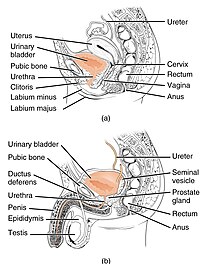
Photo from wikipedia
OBJECTIVES The aim of the present study is the assessment of thickness and percentage change in thickness of the musculus obliquus externus abdominis (OE), musculus obliquus internus abdominis (OI) and… Click to show full abstract
OBJECTIVES The aim of the present study is the assessment of thickness and percentage change in thickness of the musculus obliquus externus abdominis (OE), musculus obliquus internus abdominis (OI) and musculus transversus abdominis (TrA) among women suffering from stress urinary incontinence (SUI) in comparison with healthy controls. MATERIAL AND METHODS The thickness and its percentage changes of the OE, OI and TrA among women with and without SUI were assessed. We observed the reactions of the abdominal muscles among 84 women by means of ultrasound imaging. RESULTS The thickness of the OE was significantly greater in the SUI group during rest and tension of the lower part of the abdomen. Significant changes were found in the OI for the controls during isometric tension of the abdominal muscles, tension of the lower part of the abdomen, and ASLR (active straight leg raise) test of right leg. The thickness changes in the TrA were significant for the controls during isometric tension of the abdominal muscles. CONCLUSIONS Our results suggest interactions of the pelvic floor and the abdominal muscles during pelvic floor activity, differing in the women with SUI and controls.
Journal Title: Ginekologia polska
Year Published: 2022
Link to full text (if available)
Share on Social Media: Sign Up to like & get
recommendations!